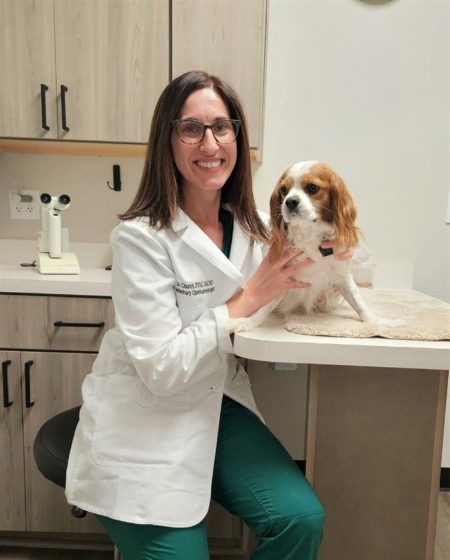Understanding Anterior Uveitis in Pets

What It Is, What It Means, and How We Treat It
What is Anterior Uveitis?
Anterior uveitis is inflammation inside the front part of the eye. It can occur in one or both eyes and is often painful for pets. While the specific signs, underlying causes, and treatment approaches can vary, what is most important is timely veterinary attention. Because anterior uveitis is often linked to other health concerns, identifying and addressing it early helps protect your pet’s vision and overall well-being.
Contact the location nearest you today to request a make an appointment for treatment at Animal Eye Care.
Common Signs in Dogs and Cats Include:
- Redness of the eye(s)
- Squinting or sensitivity to light
- Cloudiness or a bluish-white film on the eye
- Pupil that looks smaller, oddly shaped, or non-symmetric from the other eye
- Tearing or discharge
- Rubbing at the face or reluctance to be touched around the eyes
- Decreased vision (may be hard to detect in early stages)
What Causes Anterior Uveitis?
There are many possible causes, including:
- Trauma (such as scratches or blunt injury)
- Infections (bacterial, viral, fungal, tick-borne diseases)
- Immune-mediated diseases
- Cancers that affect or spread to the eye
- Lens-related problems (often related to cataracts)
Sometimes, no cause can be identified — this is called “idiopathic uveitis.”

How is Anterior Uveitis Diagnosed?
Our veterinary ophthalmologist will perform a detailed eye exam, often using special instruments to examine the inner eye structures. Additional tests may include:
- Tonometry (eye pressure testing) to rule out glaucoma
- Blood work or ocular imaging (if an underlying cause is suspected)
Treatment and Follow-Up:
Treatment depends on the cause and severity but often includes:
- Anti-inflammatory and dilating eye drops or ointments
- Systemic medications (like oral anti-inflammatories or antibiotics, if needed)
- Treating the underlying cause, if one is found
Regular follow-up exams are essential. Anterior uveitis can return or lead vision threatening complications like glaucoma or cataracts.
What’s the Prognosis?
With early diagnosis and proper care, many pets respond well to treatment. However, some pets may require ongoing management or long-term medications, especially in recurring or chronic cases. The prognosis is often dependent on the underlying cause of anterior uveitis.
Download our printable brochure: HERE
